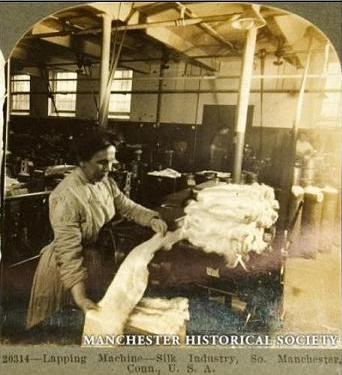



The rolls shown in the preceding view are ready for transfer to the spinning mill. Here they are carefully graded according to quality. They are then put through a lapping machine. This machine further draws out the fibres from the rolls and pulls them into continuous strips. These strips go through other drawing machines, described in the next view, before they are finally ready for the spinning frame proper.
France is the most important silk producing nation in Europe. Its manufacturing concerns not only use up all the raw product of France, which is considerable, but they also receive a great portion of the raw material imported from the Levant and from Eastern Asia. The headquarters of the silk trade in France is the city of Lyons. In it and the surrounding regions over a hundred thousand looms are in operation. The products of this center are plain and figured dress silks, and other heavy silken fabrics. The French ribbon trade is localized in St. Etienne and St. Chamond. Other French silk centers include Calais, Paris, Nimes, Tours, Roubaix and Avignon.
Germany is second to France among the countries of Europe in the extent and value of silk manufacture. Krefeld is the chief center of the silk industry in Germany. The silk industry is also a thriving one in Great Britain, Switzerland, Russia, Austria, Italy and Spain. In Italy, however, the silk trade has fallen off greatly, for in mediaeval times Genoa was famous for its gorgeous velvets and Venice and Florence for damasks and brocades. The greatest activity in Italian silk now centers in Como.
For pictures and contemporary information on the Spinning Mill or 'Clock Tower Mill' in the
"Cheney Brothers National Historic Landmark District" page, click here.

 )
)